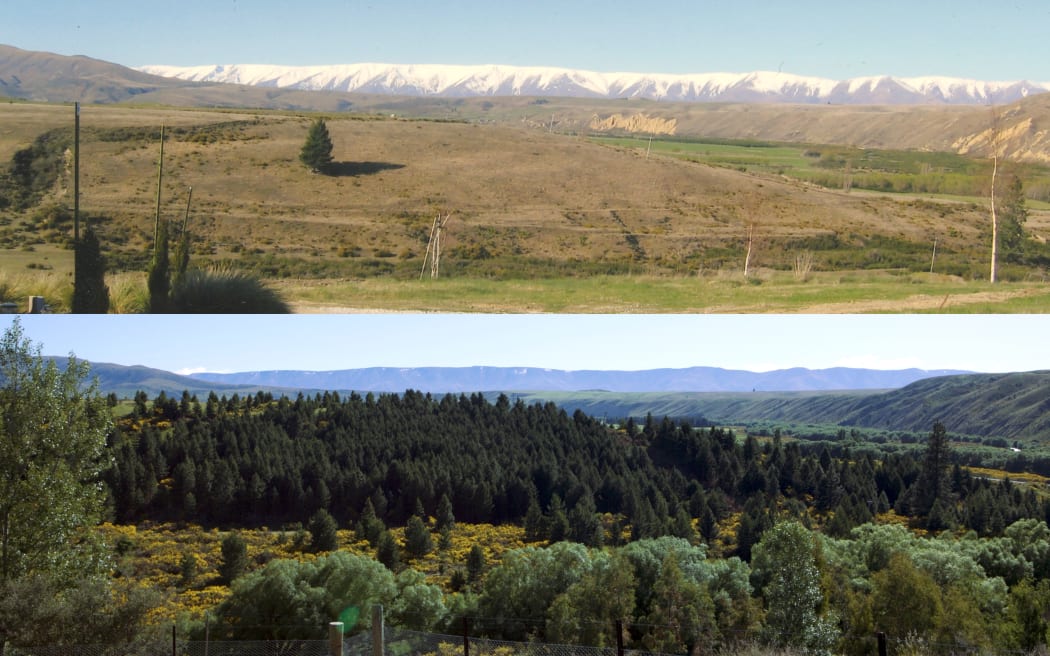There's despair from volunteers and conservationists as their hard-won gains over pest plants and animals stand to be lost in a tranche of budget cuts.

The changing view from Grahame Sydney's Central Otago home, taken 19 years apart. Photo: Grahame Sydney / Supplied
"It's a killer cancer. It kills everything in its wake and underneath it. It obliterates all other life."
Those are the words of Sir Grahame Sydney (who prefers not to use his honorific), one of New Zealand's most well-known artists, speaking about the threat of wilding pines.
He's speaking to The Detail from his Central Otago home, in the Cambrian Valley near the remote historic gold mining town of St Bathans.
Sydney is best known for his iconic paintings of Central Otago landscapes: the rugged, stark, barren landscapes among the rolling hills.
But he says wilding pines have destroyed much of it, and he can see it first-hand from his home.
"The view north to the Hawkduns and Mount St Bathans was across [a] golden, grassy, clichéd Central Otago dry landscape, with just one or two standalone pine trees amongst all the grasses. Now, that view from my place looking towards the Hawkduns is a dense forest – so dense you can't walk in it – and it's simply the result of a farmer's neglect."
He says he found it so "graphic, disappointing and worrying" he helped found the Central Otago Wilding Conifer Control Group.
That group was part of a few across the country to get record funding, but it's about to be pulled right back.
Despite a $100 million nation-wide investment over four years through the Jobs for Nature programme, the plan is to cut this to $10m a year.
For somewhere like Central Otago, Sydney says the funding cut will mean "the money has been pointlessly spent".
"Our $800,000 will probably be slashed, I imagine to $200,000 if we're lucky. For a year's operation – with paying men on the ground, paying for the chemicals, paying for the transport, the helicopters, all of it – it's totally inadequate and it means that we're going to lose the battle that we have been just slowly getting on top of."
Further north in the country's biggest urban area, Auckland Council budget cuts have left many local environmental groups feeling uncertain.
"It's genuinely heartbreaking for some people,'' Forest & Bird's regional conservation manager for Tāmaki Makaurau Carl Morgan tells The Detail.
"I know people in Forest & Bird who have been involved in local on-the-ground projects for 40-50 years ... to then get to a point where it could all be taken away from under you ... it's pretty distressing."
Morgan says there are two cuts his group is really concerned about. One is a suite of cost-saving measures to some regional community and social services netting $7.9m in cuts per annum.
"This affected things like the environment and sustainability education programmes, support for school engagement on environmental issues as well as cuts to experience centres, such as the one out in the Waitākere Ranges that help connect people to nature," he says.
"There's also the $4m reduction to local board funding per annum, so that's going to have an impact on community environmental programmes and some community grants which many of the conservation based organisations and projects rely on."
He says there were a "few hiccups" earlier in the year during the council's consultation phase, which while seemingly small, could have big consequences.
"It was reported to me that a few community groups couldn't get what they needed to carry on their conservation mahi due to 'cease spending' orders throughout various council teams."
For example, he says the Forest Ridge Community Group, which protects native birds in the Waitākere Ranges, weren't able to get money to buy bait.
"They were left hanging in the air, not really knowing what's coming next. Apparently, this was then followed by a period of a few months during which no-one really received anything.
"If you don't have funding, you have to walk away from that for a bit. The invasion of pests back into the area can happen over a couple of weeks, which then could put the group's work back a year or so."
Find out more by listening to the full episode.
Check out how to listen to and follow The Detail here.
You can also stay up-to-date by liking us on Facebook or following us on Twitter.

Photo:


